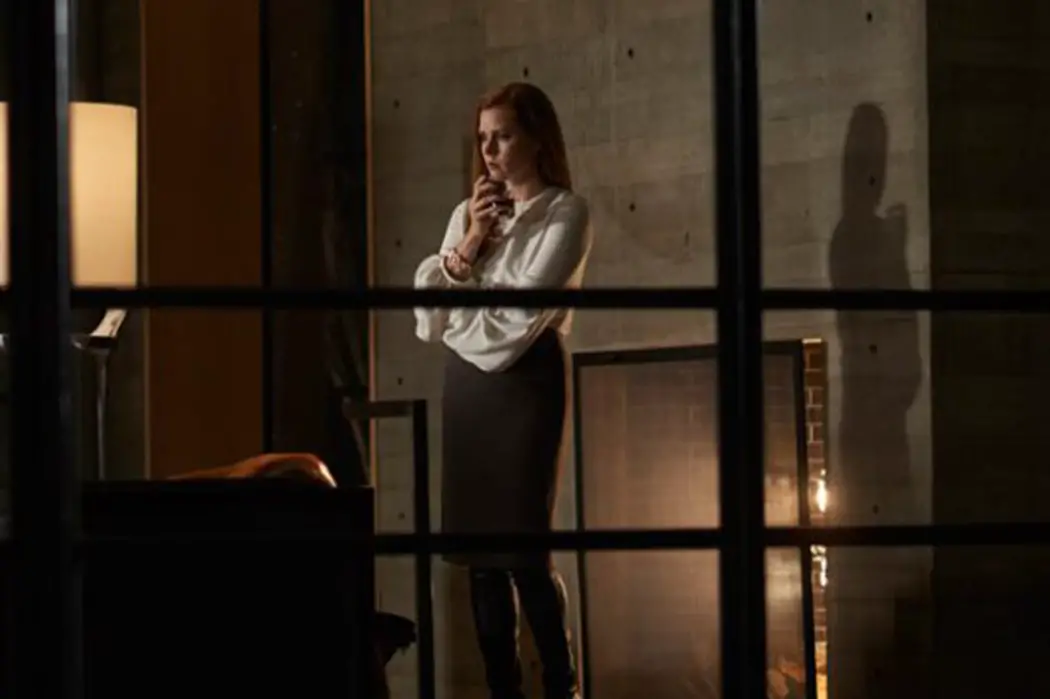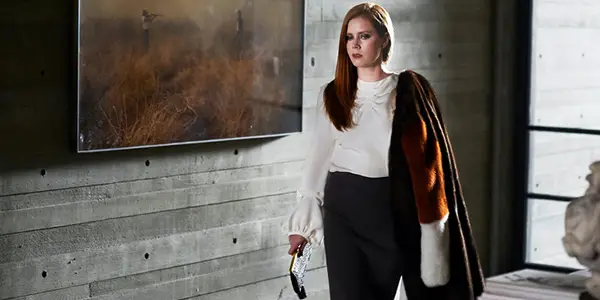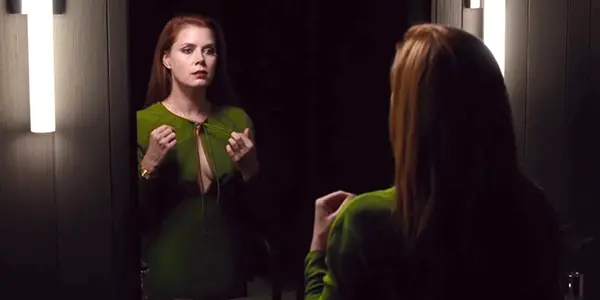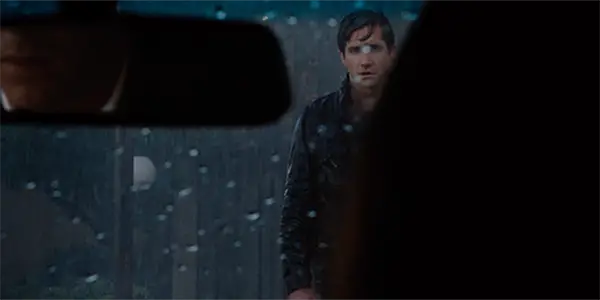NOCTURNAL ANIMALS: As Elegant & Lavish As It Is Darkly Cynical

David is a film aficionado from Colchester, Connecticut. He enjoys…
The story-within-a-story has long been used in literature and film in order to express the inner turmoil of a protagonist, albeit within an additional fictional narrative. Here, the character transposes themselves as the lead character of a story – living through that person’s experiences, and by the conclusion learns to approach their own lives in a new manner.
In Nocturnal Animals, director Tom Ford‘s sophomoric effort, this device is used to frame the entirety of the film. Presented in a lush, hypnotic fashion, the film is one wholly stemming from his unique perspective, though at times it also feels convoluted in an attempt to mesh too many alternating story-lines.
Mise en Abyme
The central plot of Nocturnal Animals concerns a woman named Susan Morrow (Amy Adams), who works as an art gallery owner in the heart of Los Angeles and is unhappily married to businessman Hutton Morrow (Armie Hammer). Upon receiving a manuscript from her ex-husband, Edward Sheffield (Jake Gyllenhaal) called Nocturnal Animals, she soon finds herself lost within its pages, finding that it parallels her own life.
The story within this manuscript is about a man named Tony Hastings (also played by Gyllenhaal), who, while on a road trip with his family in Texas, is brutally attacked by three miscreants (headed by a suprisingly savage Aaron-Taylor Johnson), leading to tragedy. The story then progresses through the aftermath of this, which leads to Tony having to face his attackers once again.
The final story-line consists of flashbacks, with Susan thinking to her past relationship with Edward, including how they met and what eventually happens to lead them to become estranged.

All told, Tom Ford‘s film is incredibly ambitious in its attempts to fuse these three story-lines together. His methods of doing so include some clever camerawork and inventive transitions; as an example, showing the fictional Tony Hastings lying in a certain position on a bed, which is then juxtaposed with Susan lying in that exact same manner while she is reading the story. Other transitions include one character speaking within the fictional story, who is then glanced at and heard by Susan as if he is actually sitting in front of her. The film is presented much like the feeling of getting lost in a good book – everything else around you fades as you become transfixed by the story.
Such efforts to combine the stories are mostly smooth, yet also occasionally feel jarring and convoluted when repeated attempts are made to combine all three story-lines. By diverting us from one story and thrusting us into another, each comes off as less balanced as a whole, and the ties between them, rather than feeling ambiguous, instead come off as overtly obvious. What might have been more effective here would have been to contain longer segments of each story before switching to the other, letting them unfold and connect to each other in a more natural way.
As it is, the fictional narrative is far more interesting than either of the real ones – though this was almost certainly an intentional move by Ford, since Susan’s changes are made through her thoughtful immersion into the story. As the film progresses, though, this almost exclusive focus causes dissonance amongst the events and characters of the additional narratives.
Characters of the “Real” and Fictional Worlds
The emphasis of Nocturnal Animals, as alluded to in its promotions, is on the character of Susan, brought to life by the wonderfully talented Amy Adams (hot off her spectacular performance in the sci-fi film Arrival). Yet, when comparing the two, her character in Arrival has much more depth and thus provides more of an opportunity for her to shine. Due to Nocturnal Animals’ intense emphasis on the fictional story within the story, Adams’ character is often overshadowed by that far more compelling narrative.
In addition, most of the events and characters within the “real” world become forgettable when thinking back to the film as a whole – Laura Linney’s and Jena Malone‘s characters, for example, barely seem to have any relevance to the story.

The true undervalued performance in the film, then, is Jake Gyllenhaal. Playing both the lead character in the frame story and the ex-husband of Susan, he gets an opportunity to show a wider range than anyone else. His character within the fictional story is especially convincing; beginning as a timid pacifist, he transitions into one of determined girth and understanding. At one point, all the grief he initially disallowed himself to accept suddenly comes into focus in an emotionally powerful breakdown, expressing the regret and angst he had repressed after his tremendous loss.
Equally as memorable as Gyllenhaal is Michael Shannon, who plays a detective within Tony Hastings’ fictional world. Shannon, as committed to the role as always, initially seems to be playing the comedic relief, yet further on in the film, his grim perspective emerges. The character comes to represent the driving force of Tony Hastings, pushing him in the direction of acceptance after his tragic experiences.
An Elegant World
Coming from a background in fashion, it should come as no surprise that Ford‘s work in Nocturnal Animals is overflowing with vibrancy. The film is lush, elegant, and as richly presented as Ford‘s latest Oscar Red Carpet dress.
Much like his previous effort A Single Man, Ford triumphs with his use of color, whether it is the crimson neon red that overcasts characters’ faces, or the oft-used transitional shot of a magnificent sunset, with purples and oranges imbuing an odd serenity to the surrounding ugliness. The outfits themselves are also opulent creations, especially those that he uses to dress Amy Adams’ character, which aptly convey her high-minded, materialistic worldview.

Much of the film is shot like a neo-noir, with an expert use of long casting shadows and unusual angles to express characters’ inner thoughts. Some shots, such as the one which overhangs Susan’s bed, even reminded me of a similar scene in Blade Runner, fitting since that film also exudes nihilistic undertones.
The most recent comparison with the film, as many other critics have noted, would be Nicolas Winding Refn‘s The Neon Demon. Both heavily contrast splendor with disgust; in Refn‘s film being the grace of beauty with the dour world of modeling that exists around it. Here, Ford shows this mostly through Adams‘s story-line, since she now works as the owner of a pretentious art gallery yet at one point wanted more than anything to become an artist on her own. Within the relentless world of Los Angeles, though, even the most hopeful of dreams will eventually crumble to dust.
Hopelessly Cynical
Nocturnal Animals is very much in alignment with this despondent outlook, and on the philosophical doctrine of nihilism in particular. The idea of the story-within-a-story, as mentioned, exists in order to create a fictional world to be compared with Susan’s current one. Though much darker, the story parallels her life in many ways.
Susan has lost people in a similar way to Tony, including being separated from Edward, and through tragic means that later caused them to stop speaking to one another. Edward’s story is a means of getting back at what she did, forcing home the idea that she was wrong and has lived a sad and forlorn life as a result – also much like Tony Hastings.
Much of fiction exists in order for us to latch onto the characters’ experiences, joining them on their journey until their final awakening at the conclusion. In both the real and fictional story of Nocturnal Animals, however, the eventual outlook that they come to is one that is extremely cynical.

This isn’t necessarily a criticism of Ford‘s film as a whole, as I can’t say that I was expecting a positive ending from a movie that had been so downcast for much of its length. The larger issue here, much like the ending of Ford’s A Single Man, is that the film spent so much time and effort on making the central characters, who we initially hated, into ones that were redeemable and likable. So by presenting the conclusion of both narratives in Nocturnal Animals as one that is hopelessly bleak, it negates all the growth that both Susan and Tony had endured during the course of the film.
You could make the argument that this is the very essence of nihilism, in that life inherently has no meaning because even the best of efforts is ultimately futile. In this case, though, some ambiguity rather than clearly-stated conclusions would have fit more in alignment with the remainder of the film.
Conclusion
Tom Ford‘s Nocturnal Animals is a film that succeeds in its richly elegant presentation – expressed in a manner that is jarring to the senses (the opening scene is very much an indicator of what’s to come). The film juggles between three concurrent story-lines, cleverly transitioning between them even if, at times, the comparisons are sometimes shoehorned in a less-than-conspicuous manner.
Hopelessly cynical and stylishly alluring, Nocturnal Animals is mostly a memorable success within the neo-noir genre and yet another indicator of the filmmaking talents of fashion designer Tom Ford.
What did you think of Nocturnal Animals? Are you a fan of neo-noir?
Nocturnal Animals is currently playing in the US and the UK. For all international release dates, click here.
Does content like this matter to you?
Become a Member and support film journalism. Unlock access to all of Film Inquiry`s great articles. Join a community of like-minded readers who are passionate about cinema - get access to our private members Network, give back to independent filmmakers, and more.
David is a film aficionado from Colchester, Connecticut. He enjoys writing, reading, analyzing, and of course, watching movies. His favorite genres are westerns, crime dramas, horror, and sci-fis. He also enjoys binge-watching TV shows on Netflix.













